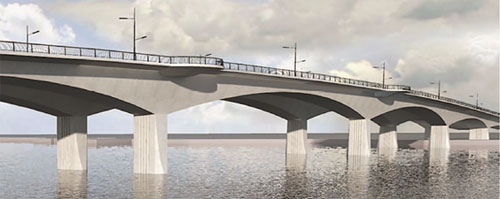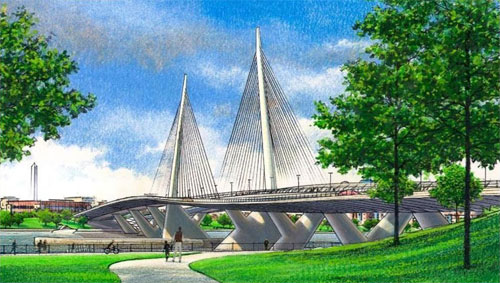Honor Frederick Douglass and DC with a worthy new bridge design
The Federick Douglass Bridge, which carries South Capitol Street over the Anacostia, will soon be rebuilt. It’s on one of DC’s main axes from the Capitol and honors a singular champion of the rights of all people regardless of race, ethnicity, or sex. But the result, so far, is an anticlimactic highway bridge that hunkers down instead of soaring.

The most recent design for the bridge. All images from DDOT.
The District Department of Transportation (DDOT) is in charge of replacing the 64-year-old rusting, pothole-filled bridge. DDOT’s “preferred” design, produced in 2011, is the “arched bascule” (a seesaw-like drawbridge).
Originally, the new bridge was supposed to look like this:

Original “arched bascule” design.
It’s not bad, but is basically a draftsman’s modernized copy of the architecturally distinguished, neoclassical Memorial Bridge across the Potomac River that is a symbolic affirmation of a reunited North and South.
Doesn’t Douglass deserve to be honored with an original design, one that’s a visual metaphor for Douglass’ very modern vision of human rights and its central place in the national narrative? (The Smithsonian’s National Portrait Gallery recognized Douglass as one of its 100 paragons of “American Cool” in an exhibition open now until Sept. 7.)
The bridge design got worse on December 31, 2012, when Mayor Gray unveiled a design that eliminated the drawbridge feature to cut the $660 million in costs by $160 million. The change removed most of the graceful—albeit not soaring—curve of the arches. The result was the design at the top of this post.
What happened? I put the question to Sanjay Kumar, Anacostia Waterfront Initiative program manager for DDOT, in March 2013. Kumar’s answer:
One of biggest concerns with the new bridge is the poor soil conditions that exist in the project area. These poor foundation conditions make construction of a deep arch structure such as the Memorial Bridge highly expensive due to the significant weight of such a structure.
When DDOT sought approval of the design by the US Commission of Fine Arts last September, members disparaged it, saying it was “little advanced from the nearby uninspired highway bridges built in the last six decades, including the existing Frederick Douglass Bridge and the recently completed 11th Street bridge.” The CFA deferred action and called on DDOT to produce an “inspired” and “bolder” look.
“This is something we can work toward,” then-DDOT Chief Engineer Ronaldo Nicholson was quoted saying in the Washington Business Journal. The agency formed several design teams to come up with an answer to CFA’s criticisms. But it also has to watch the ever-rising overall budget for the bridge. Deeper arches, as Kumar said, would be “highly expensive.”
It looks like a Hobson’s choice, but actually there’s a way for the District to produce an inspired and bolder look, and within budget. DDOT doesn’t have to go back to the drawing board. All it has to do is go into its filing cabinets and take out this “stayed-cable design.” The cables soar soar high beyond their anchors — a perfectly fitting metaphor for Douglass.

Cable-stayed design.
DDOT determined, in its environmental analysis, that the cable-stayed design is in the same price range as the arched bascule design. So cost is not an issue. DDOT officials said they chose the arched bascule because it fit in with other bridges crossing the Anacostia and Potomac. But when it turned out that the proposed arch would require a more expensive foundation, they made the arches shallower instead of changing course entirely.
Why don’t the DDOT designers take the short drive from their M Street SE offices across the old Douglass Bridge to Historic Anacostia, park their cars near the intersection of Martin Luther King Avenue and Good Hope Road SE, and do a little walking. They can go down one block to W Street and then proceed three blocks east and climb the steps to No. 1411 W Street. That will take them to Cedar Hill, where Douglass spent the last 17 years of his life. It’s the highest point in Historic Anacostia.
From it, they would see across the Anacostia River exactly what Douglass saw before he set out on his own walks: the US Capitol and the Washington Monument. Maybe they’d also see a bridge across the Anacostia that makes a web of steel a visual expression of triumph over struggle.
Then all the designers have to do is go back to their offices, get the stayed-cable design out of their file cabinets, and show it to a public that is waiting to be inspired.
